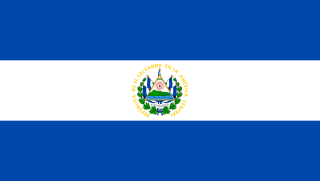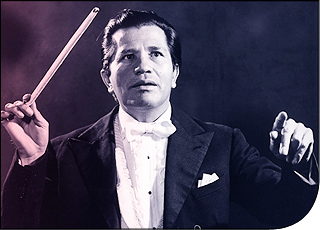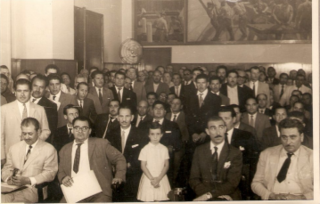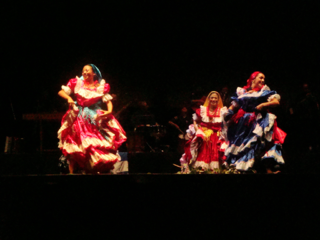
El Salvador, officially the Republic of El Salvador, is a country in Central America. It is bordered on the northeast by Honduras, on the northwest by Guatemala, and on the south by the Pacific Ocean. El Salvador's capital and largest city is San Salvador. The country's population in 2024 was estimated to be 6 million according to a government census.
The music of Latin America refers to music originating from Latin America, namely the Spanish and Portuguese-speaking regions of the Americas south of the United States. Latin American music also incorporate the indigenous music of Latin America. Due to its highly syncretic nature, Latin American music encompasses a wide variety of styles, including influential genres such as cumbia, bachata, bossa nova, merengue, rumba, salsa, samba, son, and tango. During the 20th century, many styles were influenced by the music of the United States giving rise to genres such as Latin pop, rock, jazz, hip hop, and reggaeton.

The music of El Salvador refers to the Music of the Republic of El Salvador and is encompassed in the wider Latin American musical traditions.

The culture of El Salvador is a Central American culture nation influenced by the clash of ancient Mesoamerica and medieval Iberian Peninsula. Salvadoran culture is influenced by Native American culture as well as Latin American culture. Mestizo culture, Afro-Latin culture and the Catholic Church dominates the country. Although the Romance language, Castilian Spanish, is the official and dominant language spoken in El Salvador, Salvadoran Spanish which is part of Central American Spanish has influences of Native American languages of El Salvador such as Lencan languages, Cacaopera language, Mayan languages and Pipil language, which are still spoken in some regions of El Salvador.

José Gerardo Barrios Espinoza was a Salvadoran military officer and politician who served as president of El Salvador on three occasions between June 1858 and his overthrow in October 1863.

Salvadorans, also known as Salvadorians, are citizens of El Salvador, a country in Central America. Most Salvadorans live in El Salvador, although there is also a significant Salvadoran diaspora, particularly in the United States, with smaller communities in other countries around the world.
Cojutepeque Futbol Club was a Salvadoran professional football club based in Cojutepeque, Cuscatlán. The team ceased operation in 2003.

Afro Salvadorans are Salvadorans of Sub-Saharan African descent. They are the descendants of slaves brought to El Salvador via the Trans-atlantic slave trade during the colonial Spanish era.

Esteban Servellón Torres was a Salvadoran musician, composer, and pedagogue. He composed, among other works, a Requiem Mass, a sonata for guitar, and several serenades and quartets.

Francisco Palaviccini Sandoval, also known as "Paquito" Palaviccini, was a Salvadoran composer and singer. Among his best known compositions are "Adentro Cojutepeque", "El Xuc", "El Carnaval en San Miguel", "Santa Ana Mía", "El Café de Mi Tierra", "Usulután", and "Cocotero Sonsonateco".
The Ciudad Barrios prison is a prison in Ciudad Barrios, San Miguel, El Salvador. Between September 2004 and mid-2015, it exclusively housed members of the Mara Salvatrucha gang. During this time, El Salvador had a policy of segregating gang members in its prisons; this policy has been reversed. The Ciudad Barrios prison has been militarized, with both soldiers and police officers serving as prison guards. As of 2012, the prison housed nearly 2,500 prisoners, despite a capacity of 800. Guards have relatively little control over the prison given a prisoner-to-guard ratio of 50 to one. It is one of the most violent prisons in the country.
José Kessels, born Pieter Jozef Frans Kessels, was a Dutch musician and composer who settled and worked in El Salvador. He is known for having been a teacher to various Salvadoran composers, notably David Granadino. A memorial and park in the central square of Santa Ana, El Salvador is dedicated to him.

"Adentro Cojutepeque" is a song written and composed in 1942 by Salvadoran singer-composer Francisco Palaviccini, creator of Salvadoran genre xuc. It was composed for the Cojutepeque's Cain Sugar Celebration.
Juan Carlos Fernández-Nieto is a Spanish-American pianist. He was described by Westdeutsche Allgemeine Zeitung as "A musical sculptor who chisels out melodic lines with sharp contours". and "He set off a firework on the 88 piano keys which excited the audience in the Kulturzentrum right from the start"
The Liga Mayor de Baloncesto (LMB) is a men's professional basketball league in Americas, currently composed of 9 teams. It is the premier professional men's basketball league in El Salvador. It is the top level of the El Salvador basketball league system. The league is controlled by the El Salvador Basketball Federation.
Miguel Hermosilla Ramos was a Chilean professional footballer and manager who played as a midfielder for clubs in El Salvador, Guatemala, Chile and Bolivia.

Italian Salvadorans are Salvadoran-born citizens who are fully or partially of Italian descent, whose ancestors were Italians who emigrated to El Salvador during the Italian diaspora, or Italian-born people in El Salvador.

The folklore of El Salvador shares common traits with the rest of the Mesoamerican region. In El Salvador, the presence of the ancestral civilizations of the Mayans, Toltecs, Nahuas, among others, left their presence in many aspects of daily life in the region.

The Golden Congo is a Colombian music award that since its founding in 1969 has been presented annually at the Orchestra Festival of the Barranquilla Carnival.











